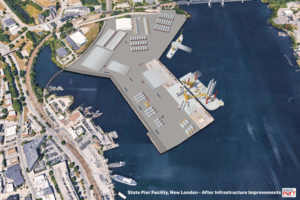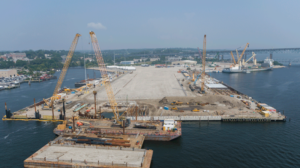Connecticut Port Authority is a public-private agency responsible for infrastructure improvements across three deep water ports in New London, Bridgeport and New Haven, alongside further infrastructure improvements across 35 small harbours in Connecticut. These infrastructure improvements are being developed to drive economic advances.
“Our mission is the maritime development of deep water and small harbours,” says Ulysses Hammond, Executive Director of the Port Authority.
One of the most exciting such developments is the New London State Pier Terminal, completely revitalising an older, existing pier.
“As a matter of fact, the state pier never achieved the success envisioned by local and state planners because it was underutilised for generations,” Hammond tells us. “Multiple studies recommended improvements to the state pier, but only in partnership with a private entity contributing funds and committing to a long-term lease arrangement.”
That is precisely the scenario Connecticut Port Authority is putting into action. The New London State Pier is going to become a functioning hub of the industry once again, acting as a staging ground for a booming offshore wind sector.
“In partnership with the Connecticut Port Authority, Ørsted, one of one the leading offshore wind companies in the world, partnered with Eversource, Connecticut’s power supplier, contributing one-third of the total costs of the pier,” Hammond says. “That’s $100 million out of the $300 million cost.”
 The state pier has been under-utilised for generations, but these new partners are not just bringing investment to the facility, they are also contributing ten years’ worth of leasing as a tenant to the terminal.
The state pier has been under-utilised for generations, but these new partners are not just bringing investment to the facility, they are also contributing ten years’ worth of leasing as a tenant to the terminal.
“They will contribute $20 million to rent the facility,” Hammond says. “But the real benefit is not just what we’re going to be able to do as a hub for staging and assembling turbines in New England, but also what we can do as a centrepiece for all kinds of heavy lift cargo in the future.”
Alongside its partners, Connecticut Port Authority is developing two piers. It is the first time a project like this has been carried out in the United States, with a capacity of 5,000 pounds per square foot.
One of those platforms has already been completed, the second will be completed later this year.
“That type of capacity transforms the state pier into a new, world-class, heavily-lift capable, climate resistant marine terminal,” Hammond points out. “That is what we are doing at this point in time. This is the first facility in the Americas built to accommodate massive offshore wind towers, including blades and nacelles simultaneously.”
Overcoming Obstructions
On its own terms, the State Pier Project is an enormous undertaking, but the pier’s location and local geographic environment bring a whole new level of challenge to the venture.
“We did a lot of surveying, but those surveys did not uncover all of the elevations and outcrops we have encountered,” Hammond admits.
“When you develop over water this is the kind of challenge you are going to face, and we are proud of how our engineering firm has come through.”
The project’s construction required driving 30-inch and 42-inch piles through high rock elevations and deep obstructions, which often necessitated a good deal of innovation and engineering skills.
“We have used all kinds of means and methods to generate that capacity of 5,000 pounds per square foot for both platforms,” Hammond says. “The engineering challenge has been enormous. We have used the auguring process, and we have drilled. We have used the down-the-hole hammer.
We have used the rock socket where you not only get through the rock but stabilise piles into the rock. It has been an engineering marvel, experiencing all the different ways we have had to get through those obstructions.”
 Visitors from as far as California and New York have come to visit the construction site and see its engineering solutions, using it as a template to figure out how to replicate their success. In discussing that success, Hammond heaps praise on the engineering and other partners who have worked with the Connecticut Port Authority through this project.
Visitors from as far as California and New York have come to visit the construction site and see its engineering solutions, using it as a template to figure out how to replicate their success. In discussing that success, Hammond heaps praise on the engineering and other partners who have worked with the Connecticut Port Authority through this project.
“Our engineering outlet is Moffatt & Nichol, who has experience in this kind of project when it comes to pile driving and working in the water down to the seabed,” he tells us. “We were fortunate to have a very competent engineering firm to work with.”
As well as Moffatt & Nichol, Connecticut Port Authority has had strong working relationships with marine and dredging firm Jay Cashman, and the Connecticut-based Mohawk Northeast Inc, which specialise in heavy construction, marine construction, and tugboat transportation.
“This was all supervised by our construction administrator AECOM, who provided oversight over the entire construction project,” Hammond says.
A New Industry
With one pier complete, and another one underway, the facility has already been contracted to assist with offshore wind projects for New York, Rhode Island, and of course, Connecticut.
“We will be staging and assembling a total of 160 turbines with an output of 1760mw, which is enough power for one million homes in these three states,” Hammond points out.
The South Fork Wind project will produce 132mw of power for the state of New York and it will be the first to be placed in federal waters- another first in this country’s history, while Sunrise Wind will produce roughly 924mw on top of that. Revolution Wind will produce 304mw for the state of Connecticut, and 400mw for Rhode Island.
“One of the primary reasons New London was selected for this project is because of our location, with no vertical or horizontal obstructions heading out to federal waters,” Hammond says.
This project will be assisted by the first United States Jones Act Turbine Installation Vessel Charybdis, which is being built in Texas by Dominion Power. The ship is 472 feet long and about 150 feet wide and New London State Pier will be its first port of call for the installation of turbines.
“It is very impressive and next year it will be commissioned for the Revolution Wind and Sunrise Wind projects,” says Hammond.
The Port Authority is already being courted by other developers for the opportunity to use this new site for staging and assembly.
“Whenever there is downtime our terminal operator Gateway Terminal, a first-class terminal operation company will
have the ability to market this for international commerce,” Hammond says. “The pier will place Connecticut in a position of real prominence among East Coast ports, and at the forefront of a new industry.”






